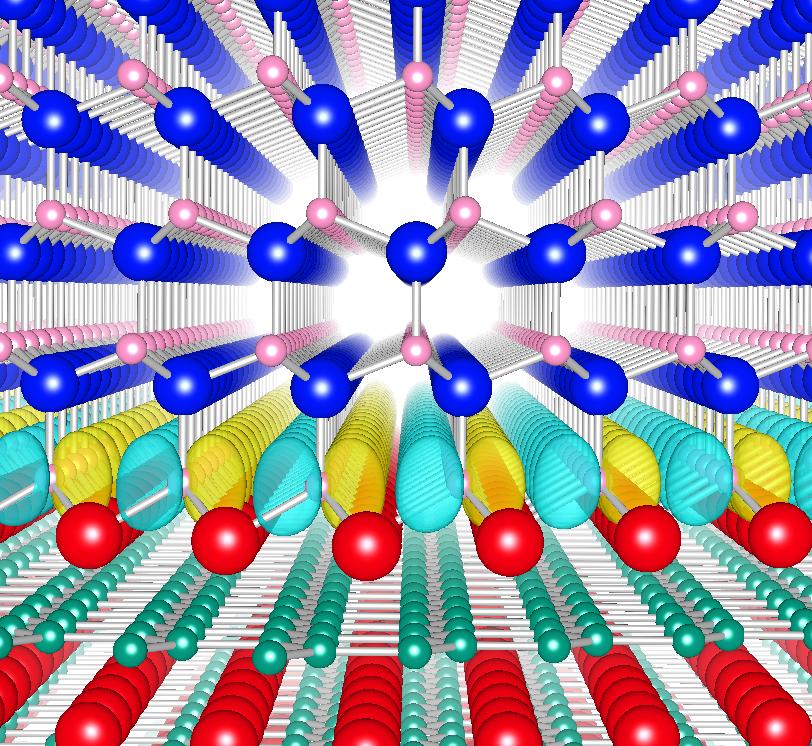Research
"Itinerant ferromagnetism at interfaces of nonmagnetic materials"
 Nitrides are of significant importance in potential applications to
spintronics as well as optoelectronics widely used already. Spin
polarization without magnetic elements is possible utilizing dangling
bonds. In particular, nitrogen-dangling bonds of cation vacancies are
responsible for spin polarization in nitride
semiconductors [1]. Enhancement of
ferromagnetism due to cation vacancies by Gd dopants in GaN has also
been found [2], which is consistent with colossal magnetic
moments per Gd observed in experiments. However, randomness of
point-defect distribution is not feasible to control magnetization. In
this situation, ordered structures of spin sites are highly desirable
for the control of magnetization, where interfacial atomic sites could
be useful. Lattice-matched nitride interfaces have been examined, in
particular, for GaN/ZrB2(0001) interfaces well defined on the
atomic scale, whereas AlN/MgB2(0001) interfaces fabricated thus far
are not atomically clean.
Nitrides are of significant importance in potential applications to
spintronics as well as optoelectronics widely used already. Spin
polarization without magnetic elements is possible utilizing dangling
bonds. In particular, nitrogen-dangling bonds of cation vacancies are
responsible for spin polarization in nitride
semiconductors [1]. Enhancement of
ferromagnetism due to cation vacancies by Gd dopants in GaN has also
been found [2], which is consistent with colossal magnetic
moments per Gd observed in experiments. However, randomness of
point-defect distribution is not feasible to control magnetization. In
this situation, ordered structures of spin sites are highly desirable
for the control of magnetization, where interfacial atomic sites could
be useful. Lattice-matched nitride interfaces have been examined, in
particular, for GaN/ZrB2(0001) interfaces well defined on the
atomic scale, whereas AlN/MgB2(0001) interfaces fabricated thus far
are not atomically clean. In this study, first-principles calculations have demonstrated that intrinsic two-dimensional ferromagnetism (prohibited within the model-Hamiltonian approach) is indeed possible at AlN/MgB2 interfaces [3]. Partially occupied N p|| states at AlN/MgB2(0001) interfaces exhibit two-dimensional spin polarization around the Fermi level (See Figure), which cannot be anticipated from the atomic structure, because the N dangling bonds are apparently saturated by Mg atoms. Strong itinerant ferromagnetism comes from Hund's coupling of the two N p|| orbitals as well as avoided high density of states at the Fermi energy by the exchange splitting that is comparable to typical band ferromagnets. In addition, we have identified that this interfacial spin polarization is responsible for quantum spin transport, and may be controlled by applied gate bias voltages. We have also found that GaN/ZrB2(0001) interfaces do not exhibit spin polarization due to screening effects of metal-induced gap states [4].
[1] Y. Gohda and A. Oshiyama, "Stabilization Mechanism of Vacancies in Group-III Nitrides: Exchange Splitting and Electron Transfer", J. Phys. Soc. Jpn. 79, 083705 (2010).
[2] Y. Gohda and A. Oshiyama, "Intrinsic ferromagnetism due to cation vacancies in Gd-doped GaN: First-principles calculations", Phys. Rev. B 78, 161201(R) (2008).
[3] Y. Gohda and S. Tsuneyuki, "Two-dimensional intrinsic ferromagnetism at nitride-boride interfaces", Phys. Rev. Lett. 106, 047201 (2011).
[4] Y. Gohda, S. Watanabe, and A. Gross, "Quantum Electron Transport through Ultrathin Si Films: Effects of Interface Passivation on Fermi-Level Pinning", Phys. Rev. Lett. 101, 166801 (2008).